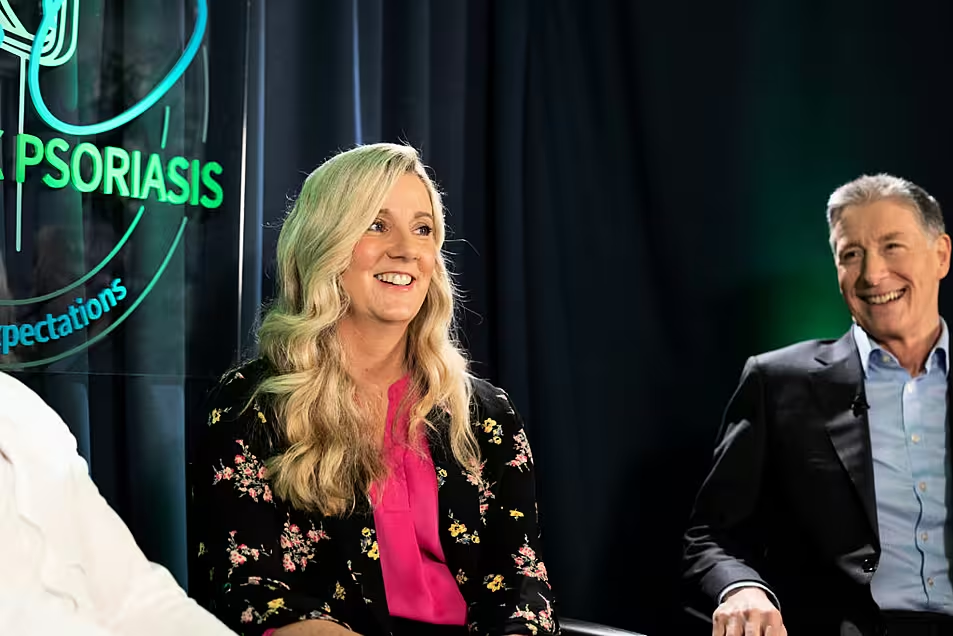Despite it being relatively common in people with psoriasis, affecting up to one-third of those with the condition, psoriatic arthritis often goes undiscovered for a time.
The myths and misunderstandings surrounding psoriatic arthritis are addressed in the fourth and final episode of the new video and podcast series PsO Let’s Talk Psoriasis from Janssen Sciences Ireland UC. The series aims to support and empower people living with psoriasis and psoriatic arthritis as they await access to specialist care by offering them access to expert advice.
Around 30,000 people in Ireland may be living with psoriatic arthritis, according to professor Douglas Veale, a consultant rheumatologist and professor of Medicine at St Vincent’s University Hospital, who appears in the latest episode.
Yet the condition has a wide range of clinical features associated with it, which may differ from patient to patient. This makes it difficult to pin down what exactly the condition is, or which type of clinical specialist the patient should be referred to, Veale admits.
Essentially a form of inflammatory arthritis, psoriatic arthritis can cause a whole host of problems, from joint pain, swelling and back pain, to skin and nail issues.
Fatigue
Fatigue is also a common symptom.1 “It has lots of different presentations, which adds to the complexity of the disease and also why sometimes patients are reluctant to attend a doctor or even maybe will attend the wrong type of specialist and therefore the diagnosis doesn't get made because all of these areas don't seem to be clicked together,” Veale explains.
Grainne O’Leary, chief executive of Arthritis Ireland, agrees that while awareness of the condition is poor, the non-specific nature of its symptoms make it particularly difficult to diagnose in a prompt fashion.
“There is definitely an awareness issue,” she admits. “It’s always very interesting when you meet a patient cohort who have psoriatic arthritis – you hear about the difficulty and often the long roads that people have embarked upon to be diagnosed.”
People tend to be more familiar with arthritis in terms of rheumatoid arthritis or osteoarthritis, she says. “Some of the indicators that are there in rheumatoid arthritis are not always there in psoriatic arthritis, so patients can fall between two stools. And what might look like rheumatoid arthritis doesn’t show up routinely in a blood test the way rheumatoid would.”
And although psoriatic arthritis is invariably a consequence of psoriasis, people can fail to make that connection, O’Leary says. “The concept of psoriasis as an autoimmune condition is something that people don’t often fully understand. They are wondering, 'how could something that affects my skin affect my joints', they are thinking they are two different things entirely but of course there is a very strong link.”
Diagnosis
In some cases, it can be the minor symptoms that eventually tips the balance towards diagnosis of the condition, she adds. “Pitting of the nails is one of the signs that might be the thing that led them to being diagnosed, or perhaps eye pain or redness in the eyes, or tenderness around the joints as well as stiffness. Some women simply realise they can no longer put their wedding ring back on.”
The first step in managing psoriatic arthritis is actually prevention – getting psoriasis under control will reduce the possibility of developing psoriatic arthritis. “The more severe your psoriasis is, the more likely it is that you would develop psoriatic arthritis,” notes O’Leary.
Identifying the patients most likely to progress to psoriatic arthritis is a major challenge for clinicians, adds Veale – these will be the cohort who need earlier intervention with stronger medications.

“In most cases the psoriasis will be present before the arthritis, and people will start with topical treatments, so creams and lotions and potions. And then there's tablet treatments, which have been around for a long time, and some of them are very effective for some people,” he says.
“In the last 20 years, a lot of the injection type treatments have really been a game changer. They control the inflammation… and reduce a lot of the symptoms, but importantly, they also prevent damage to the joints. And as a rheumatologist, we're always really looking at that sort of prevention of future damage.
"Occasionally in very severe cases, we might combine the tablets and the injections at the same time from the beginning, particularly in a younger person, to try and prevent that damage.”
Self-management
Arthritis Ireland has helped to pioneer self-management in chronic diseases with its popular “Living Well with Arthritis” self-management programme. In the episode, O’Leary offers a number of tips for those seeking to gain control of their psoriatic arthritis and enhance the benefit of their particular treatment.
The first thing is monitoring your disease, she says. “If you feel it is getting worse or there is something you don’t like the look of, get in touch with your healthcare team about it.”
Adherence to medications is also key. “Taking medications as prescribed and as discussed with your doctor – it might sound obvious, but that’s really important and isn’t always done.”
Exercise
Both O’Leary and Veale are big advocates for physical activity, even with a condition that leads to pain and fatigue.
“Exercise is one of the most important things anyone with psoriatic arthritis can do,” O’Leary says, acknowledging that it can be more difficult to be active during a flare of the condition. “It can be hard when your disease is not as well controlled, when you have pain, but it is about getting the right balance between exercise and rest.”
There is no specific type of exercise that will help, she adds. “Different types of exercise programmes suit different people. Primarily it’s about trying to promote good strong muscles and flexible joints so that you are giving protection to your joints and preserving that range of movement in your joints.

O’Leary suggests that patients embarking on an exercise regime first have a chat with a chartered physiotherapist to gain confidence in their ability to exercise safely. “People have a fear about making their pain worse.”
It almost goes without saying exercise should be coupled with a healthy diet but dietary advice suggesting the avoidance of certain foods is also debunked in the podcast. “There is no wonder diet out there, but a healthy well-balanced diet is key,” says O’Leary.
PsO Let’s Talk Psoriasis is available free online, with the four episodes released on a weekly basis throughout May, at www.janssenwithme.ie/pso/resources/pso-lets-talk-psoriasis. The audio versions are available on all popular podcast platforms.
References are available upon request.








